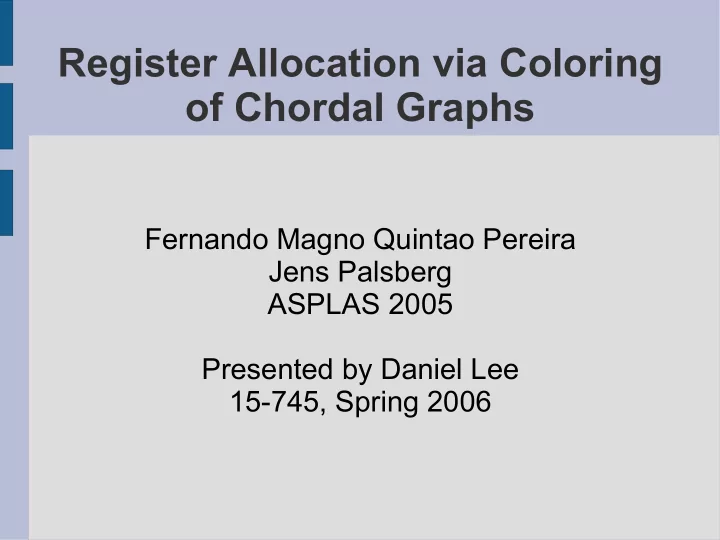

Register Allocation via Coloring of Chordal Graphs Fernando Magno Quintao Pereira Jens Palsberg ASPLAS 2005 Presented by Daniel Lee 15-745, Spring 2006
Register Allocation Compilers traditionally generate code for a specific architecture assuming there is an infinite number of temporaries (registers). However, real chips have a finite number of registers. Register allocation is the problem of safely mapping temporaries to a finite supply of registers.
Register Allocation is NP Complete Shown by Chaitin via reduction from graph coloring. Most algorithms for register allocation reduce register allocation to the coloring of interference graphs. Despite being NP-complete, there are many reasonably fast approximation algorithms for register allocation, Iterative Register Coloring or whatever voodoo gcc does.
Register Allocation is not always NP Complete! For certain classes of graphs, graph coloring is solvable optimally in polynomial time. Many interference graphs generated by real programs falls into one or more of these classes (perfect graphs, 1-perfect graphs, chordal graphs). Polynomial time graph coloring for perfect graphs is complicated.
Chordal Graphs However, graph coloring for chordal graphs is beautifully simple and O(|v| + |e|). A chordal graph has the property that every cycle with 4 or more edges has a chord. A chord is an edge that connects two vertices in the cycle but is not part of the cycle. Programs in strict SSA form have chordal interference graphs, result due to Sebastian Hack.
Greedy Graph Coloring Give an arbitrary ordering to your colors. While there is a node that has not been colored, assign it the lowest color that has not already been assigned to one of its neighbors. That's it. This procedure is O(|e|).
Simplicial Elimination Ordering A clique is a fully connected graph. A vertex v in graph G is simplicial if its neighborhood in G is a clique. ● A simplicial elimination ordering of G is a bijection s : V (G) -> {1,...,|V|}, such that every vertex vi is a simplicial vertex in the subgraph induced by v1,...,vi. ● Theorem: a graph is chordal iff it possesses a simplicial elimination ordering.
Optimal Chordal Graph Coloring Greedy coloring is optimal for chordal graphs if vertices are colored in a simplicial elimination ordering. A simplicial elimination ordering can be determined by Maximal Cardinality Search, which runs in O(|e|+|v|). The algorithm for MCS is in the paper.
Spilling A snazzy graph coloring algorithm does not a register allocator make. Even when optimally allocated, some interference graphs will not fit into however many registers your machine has. These values must be spilled onto the stack. Optimal spilling is NP-complete.
Pereira-Palsberg Register Allocation Observation: 95% of interference graphs generated by a large sample of code have chordal interference graphs. Even if the graph is not chordal, the greedy algorithm will give a reasonable coloring. Result: a non-iterative register allocator based on greedy coloring for chordal graphs and powerful heuristics for spilling and coalescing.
P-P Register Allocation: Phases Build interference graph Optional: MCS and then pre-spilling. MCS Greedy Coloring (with an unbounded number of colors) Post-spilling (removes extra colors by spilling) Coalescing
Pre-spilling Calculate maximal cliques. Spill vertices at their intersections until the result is k-colorable (so post spilling will never be necessary). If the graph is not chordal, this may produce unnecessary spills.
Spilling Heuristics Easy to implement: spill the highest colors in the color ordering. Better, but harder to implement: spill the colors that are used the least. Not addressed in paper: inner-loop considerations.
Coalescing Heuristic When there is a move instruction r1 := r2, it is desirable to try to coalesce these into the same register. The heuristic used by P-P is to coalesce r1 and r2 if there is a register r3 that is not used by a neighbor of r1 or a neighbor of r2. This is unique in that it happens last (in IRC, coalescing happens before spilling). Coalescing would cause some chordal graphs to become non-chordal.
Comparisons with IRC Iterated register coloring is... iterative. If spilling occurs, the interference graph must be reconstructed and the process repeated. (From personal experience) iterative register coloring is a pain to implement. P-P requires only one pass.
Experimental Results Paper, page 12. Over 90% of the interference graphs seen were chordal. On average uses fewer registers, spills fewer registers, and finds more opportunities for coalescing. Better worst case spilling behavior. Variations depending on which spilling heuristic is used. Overall, the least-used color heuristic is best.
Recommend
More recommend